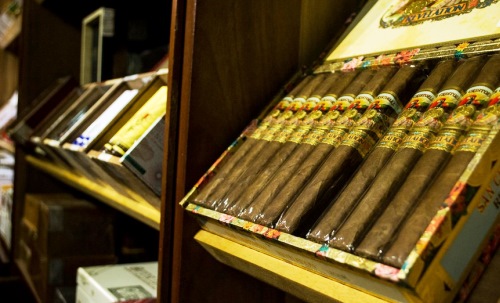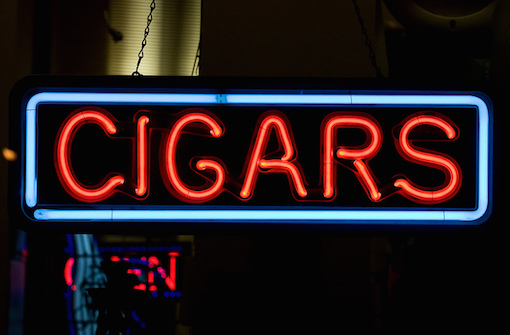Stogie Guys Friday Sampler No. 416
6 Feb 2015
As we have since July 2006, each Friday we’ll post a mixed bag of quick cigar news and other items of interest. Below is our latest Friday Sampler.
 1) Changes for U.S.-Cuban relations were announced by President Obama in December, but they fell short of ending the trade embargo outright or legalizing all travel to the island. Americans still need to be officially licensed to legally travel to Cuba, and such licenses are restricted to purposes such as education, religion, government business, and visiting family members. However, bipartisan legislation—S. 299, the “Freedom to Travel to Cuba Actâ€â€”was recently introduced in the Senate to repeal all restrictions on travel by Americans to Cuba, and a House version of the bill is expected shortly. The American Society of Travel Agents estimates “at least two million additional Americans would visit Cuba by 2017 if there were to be a full lifting of travel restrictions in 2015.â€
1) Changes for U.S.-Cuban relations were announced by President Obama in December, but they fell short of ending the trade embargo outright or legalizing all travel to the island. Americans still need to be officially licensed to legally travel to Cuba, and such licenses are restricted to purposes such as education, religion, government business, and visiting family members. However, bipartisan legislation—S. 299, the “Freedom to Travel to Cuba Actâ€â€”was recently introduced in the Senate to repeal all restrictions on travel by Americans to Cuba, and a House version of the bill is expected shortly. The American Society of Travel Agents estimates “at least two million additional Americans would visit Cuba by 2017 if there were to be a full lifting of travel restrictions in 2015.â€
2) This week the Miami New Times published an article titled “The End of the Embargo Could Kill Miami’s Cuban Cigar Industry.” While the headline may be sensationalistic, bordering on absurd, the story contains some fascinating history, in particular an in-depth interview with José Orlando Padrón. Padrón describes his fascinating and often tumultuous life experiences, which include: having his family’s Cuban tobacco farms seized by Castro’s government; meeting Castro and even sharing a cigar with the dictator while on a trip to push for the release of 4,000 political prisoners after the communist revolution; the violent backlash he faced in Miami and Nicaragua for being seen as too close to Castro after a newspaper published a photo of Castro smoking a Padrón cigar; meeting Nicaraguan strongman Anastasio Somoza who showed Padrón the potential of Nicaraguan tobacco; and fleeing Nicaragua for Honduras after the Nicaraguan Sandinista revolution led to his factory being burnt down. The whole article is worth reading for Padrón’s story alone.
3) According to Reuters: “Dr. Margaret Hamburg, who as commissioner of the U.S. Food and Drug Administration (FDA) for almost six years has overseen public health initiatives ranging from tobacco control and food safety to personalized medicine and drug approvals, is stepping down, the agency said on Thursday. Hamburg, 59, is one of the longest-serving FDA commissioners in the modern era. She was nominated by President Barack Obama and confirmed by the U.S. Senate in May 2009 and last year was named the world’s 51st most powerful woman by Forbes magazine… Dr. Stephen Ostroff, the FDA’s chief scientist, will fill Hamburg’s position until a new commissioner is named.â€
4) Inside the Industry: Viva Republica is set to launch what will certainly be one of the most bizarre cigars of 2015. Called Jailbreak, it’s a lancero buried inside a larger cigar. “The cigar features a double-wrapper (Dominican Corojo and Ecuadorian Habano), undisclosed double-binder, and features ten different filler leaves,†according to a press release. “The lancero/center-chamber is rolled and aged prior to being re-rolled into the 6 x 58, which is then aged again.†Only 300 20-count boxes will be made. Jailbreak will retail for $12.50.
5) Deal of the Week: As we noted a few weeks ago, AVO’s re-branding/re-blending has resulted in some excellent deals on older AVO offerings. These deals from Emerson’s are no exception. Buy any box of AVO cigars and receive a 10-pack of AVO Classic No. 2 cigars (valued at over $100). We’d particularly recommend the AVO Heritage line, which starts at just $112 for a box (plus the bonus 10-pack).
photo credit: Flickr




 As a full-blown fan of cigars coming from Rafael Nodal and Hank Bischoff, I always expect good things when I light a cigar from their Boutique Blends. So it was no surprise that I liked La Bohème, even though I was a bit unsure of what to expect from the small Mimi. After all, even Nodal has said he wasn’t too sure about it at first.
As a full-blown fan of cigars coming from Rafael Nodal and Hank Bischoff, I always expect good things when I light a cigar from their Boutique Blends. So it was no surprise that I liked La Bohème, even though I was a bit unsure of what to expect from the small Mimi. After all, even Nodal has said he wasn’t too sure about it at first.

 Patrick Ashby
Co-Founder & Editor in Chief
Patrick Ashby
Co-Founder & Editor in Chief Patrick Semmens
Co-Founder & Publisher
Patrick Semmens
Co-Founder & Publisher George Edmonson
Tampa Bureau Chief
George Edmonson
Tampa Bureau Chief